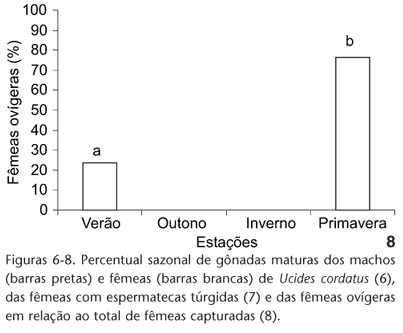The aim of this work is to characterize, for the first time, aspects of the reproduction of the mandrove-land crab in mangroves of the Babitonga Bay (Santa Catarina). Furthermore, density and stock size of this fishery resource were also estimated. The specimens were sampled from May 2002 to April 2003, from two distinct locations: Iperoba and Palmital; a total of 2265 specimens (1623 males and 642 females) were analyzed. Males with mature gonads were recorded throughout the year, while females with mature gonads were only recorded during a five-month period. Ovigerous females were recorded in December and January. The ethogram of the reproductive migration phenomenon ("andada") is in agreement of high crab activity associated to full- and new-moon, with higher intensity during December and January, also related to the austral summer season. The total sampling density on Iperoba Mangrove was 2.05 ± 0.97 individuals.m-2 and did not differ significantly (p < 0.05) from the density recorded on Palmital Mangrove (2.06 ± 1.08 individuals.m-2). The overall average of density estimation at Babitonga Bay was 2.05 ± 1.00 individuals.m-2, which corresponded to the density of open (1.42 ± 0.89 individuals.m-2) and closed burrows (0.64 ± 0.63 individuals.m-2).
Andada; fishery; reproduction; sampling density













